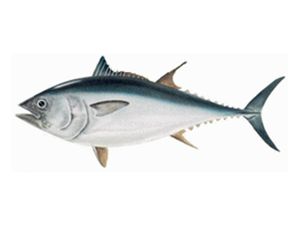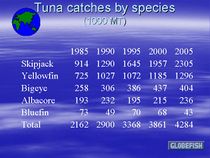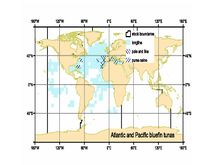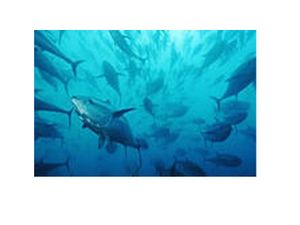The Tragedy of the Commons - The Tuna Example
Contents
Overview of the tragedy of the commons
The tragedy of the commons refers to a paper which was written by biologist Garret Hardin in 1968. He used the expression as a metaphor for the problems of overuse and degradation of natural resources including the destruction of fisheries, the over harvesting of timber, and the degradation of water resources[1]. The word tragedy refers to the depletion of the common fish resources and the commons stands for common ownership, hence the absence of private ownership and property rights[2].
Tragedy of the commons – an example
Hardin's analysis focuses on a pasture that herders use in common for grazing their cattle. There are no problems with the common usage of the pasture until the number of animals reaches the carrying capacity of the pasture. In order to gain extra profits, herders add additional animals to the common pasture. The problem is that each additional animal means more grazing in the pasture, and the continual addition of animals eventually leads to overgrazing of the pasture. The end result is the destruction of the pasture. In the words of Hardin, "each man is locked into a system that compels him to increase his herd without limit-in a world that is limited"[3].
Fishery in the tragedy of the commons scenario
Fisheries are similar to Hardin’s pasture in that increased fishing pressure has caused certain stocks of fish to become over fished to a point that threatens the survival of the fishery. All the conditions described by Hardin are met in this case: an unrestricted number of users, unfettered by any limits on their access, extract an increasing share of a resource until natural resources are severely depleted. Fishers tend to have little incentive to practice conservation, for they know that if they do not catch the available fish, someone else probably will[4].
Fish resources all over the world are in danger of extinction, the major risks being:
- An excessive fishing fleet capacity and fishing effort
- Depleted fish stock
- Low profitability (operating surpluses near zero)
- High inter-annual variability of stock size and catches
- Excessive risk of collapse of fish stocks[5]
It should be noted that alongside these factors others such as water pollution in particular with heavy metals, persistent organic pollutants, nutrients from agriculture and oil, in marine and coastal areas have also played a decisive role in the reducing fish stocks[6]. The oceans have been called a common heritage resource – they belong to everyone and no one. But under the 1982 Law of the Sea, agreed to under United Nations auspices, nation can claim territorial rights to many important offshore fisheries. They can then limit access these fisheries by requiring fishing licenses.
The Tuna Example
Tuna are several species of ocean-dwelling fish in the family Scombridae, mostly in the genus Thunnus. Tunas are fast swimmers—they have been clocked at 70 km/h (43 mph)—and include several species that are warm-blooded. Tunas are sub-classified into five genera (Thunnus, Euthynnus, Katsuwonus, Auxis and Allothunnus) with fifteen species altogether. They are all oceanic, capable of long migrations or movements[7]. Total catch of the five main tuna species expanded quite strongly between 1985- 2005: from 2.16 million MT to over 4.2 million MT, The main tuna catching nations are concentrated in Asia, with Japan and Taiwan (Province of China) as the main producers. Other important tuna catching nations in Asia are Indonesia, the Republic of Korea and the Philippines[8].
Growing demand for tuna products has been stimulating increases in the catches. At the same time, demand for tuna has been keeping prices at levels that have ensured adequate income for all stakeholders. However, in the case of some species such as skipjack continuous high exploitation has created an excess of supply, causing prices, and therefore income of operators, to decline.
Management of tuna
There are five regional bodies responsible for managing tuna stocks:
- Commission for the Conservation of Southern Bluefin Tuna
- Inter-American Tropical Tuna Commission
- International Commission for the Conservation of Atlantic Tunas
- Indian Ocean Tuna Commission
- Western and Central Pacific Fisheries Commission
The five met together for the first time in Kobe, Japan in January 2007. The meeting concluded with an action plan drafted by some 60 countries or areas. Concrete steps include issuing certificates of origin to prevent illegal fishing and greater transparency in the setting of regional fishing quotas.
The case of the Atlantic bluefin tuna (Thunnus thynnus)
Atlantic, Pacific and southern bluefin contribute relatively little in terms of volume to the total catches of principal market tunas, but their individual value is high due to their use for sashimi and sushi (Japanese delicacy). These fish are migratory and are known to traverse the Atlantic Ocean in a few months. Bluefin tuna are among the largest bony fish in the ocean, reaching over 3.05 meters in length and over 500 kilograms in weight. Their lifespan can exceed 30 years, making them long lived among fish species [9].
Catches of Atlantic bluefin followed a generally declining trend from the early 1950s to the early 1970s [10]. The Atlantic population of the species has declined by nearly 90 percent since the 1970s [11]. Atlantic bluefin tuna take eight years to mature to large-medium sized fish. Scientists believe that the decline in the numbers of larger sized bluefin tuna can be attributed to the high volume of juvenile bluefin tuna caught. The problem is that fishers catch so many juvenile bluefin tunas that there are none left to mature [12].
There are two ways to save the Atlantic bluefin tuna stock- protect them in their breeding grounds and in their feeding grounds. This will require immediate action in both the central Atlantic, to reduce the mortality of the giant bluefin while foraging, and in the Gulf of Mexico and Mediterranean, where bluefin breed as discrete populations [13].
The International Commission for the Conservation of Atlantic Tuna (ICCAT) has recommended, in light of severe stress on the Atlantic Ocean’s population of bluefin tuna that, for the indefinite future, no commercial fishing for juvenile fish or this species is allowed[14].
Conclusion
It is difficult to be prescriptive regarding what is an appropriate extractive policy for a fishery; the policy will differ depending on the individual characteristics of the fishery, the fishers and the objectives of the property right holder. Some form of regulation is needed in a fishery to prevent the “tragedy of the commons” – where individual fishers are motivated to operate beyond the maximum sustainable yield, often leading to biological and economic over-exploitation. Without a clearly defined set of policies, the consequent institutions may not achieve a desired result[15].
See also
Internal links
- Effects of fisheries on marine biodiversity
- Legislation for the sea
- The tragedy of the commons: Is the Newfoundland's cod crisis a good example?
External links
Economics of fisheries- Encyclopedia of Earth
References
- ↑ Ostrom, E., J. Burger, et al. (1999). Revisiting the Commons: Local Lessons, Global Challenges. Science 284 (5412): 278
- ↑ Hillmann, Ayre L. “Private ; (2002) Solutions for Externalities, Responsibilities and Limitations of Governments”, Public Finance and Public Policy, Cambridge, Cambridge University Press, p.231
- ↑ Garrett Hardin, (1968) The Tragedy of the Commons, Science, December 13,1968, p.1243
- ↑ Harris, Jonathan; Codur Anne-Marie; (2007) Economics of fisheries, Encyclopedia of Earth, www.eoearth.org/article/Economics_of_fisheries
- ↑ Shepherd, J.G;(2003) “Economic Aspects of Fisheries Management” in Sustainable Fisheries: Myth or Mirage School of Ocean & Earth Science, University of Southampton
- ↑ “The State of Environment- Europe and Central Asia, Marine and coastal areas” in UNEP Global Environment Outlook 2000
- ↑ Allen, R. L. (2002). Global tuna resources: limits to growth and sustainability. In S. Subasinghe & P. Sudari eds. Global tuna industry situation and outlook: resources, production & marketing trends and technological issues. Proceedings of the Tuna 2002 Kuala Lumpur, 7th INFOFISH World Tuna Trade Conference. Kuala Lumpur, Malaysia, 30 May-1 June, 2002, pp. 3-12. Kuala Lumpur, INFOFISH. 208 pp.
- ↑ Josupeit, Helga; (2004) Global World Tuna Markets” INFOFISH TUNA CONFERENCE 3-5 June 2004, Bangkok, Thailand, Food and Agriculture Organisation
- ↑ An Assessment of Atlantic Bluefin Tuna (1994), Committee to Review Atlantic Bluefin Tuna, Ocean Studies Board, Commission on Geosciences, Environment and Resources (CGER), National Academy Press; page 5
- ↑ Allen, R. L. (2002) Global tuna resources: limits to growth and sustainability. In S. Subasinghe & P. Sudari, eds. Global tuna industry situation and outlook: resources, production & marketing trends and technological issues, page 168
- ↑ Safina; (1996). Thunnus thynnus. 2006 IUCN Red List of Threatened Species. IUCN 2006. Retrieved on 12 May 2006
- ↑ Nickler, Patrick; (1999), A tragedy of the commons in coastal fisheries: Contending prescriptions for conservation, and the case of the Atlantic bluefin tuna, page 3
- ↑ Radford, Tim; (2005) Scientists call for urgent action to save Atlantic Tuna, The Guardian, April 28 2005
- ↑ Nickler, Patrick; (1999), A tragedy of the commons in coastal fisheries: Contending prescriptions for conservation, and the case of the Atlantic bluefin tuna, page 1
- ↑ Peterson, Elizabeth H;(2006) Institutional Economics and Fisheries Management, The Case of Pacific Tuna, page 40
Please note that others may also have edited the contents of this article.
|



